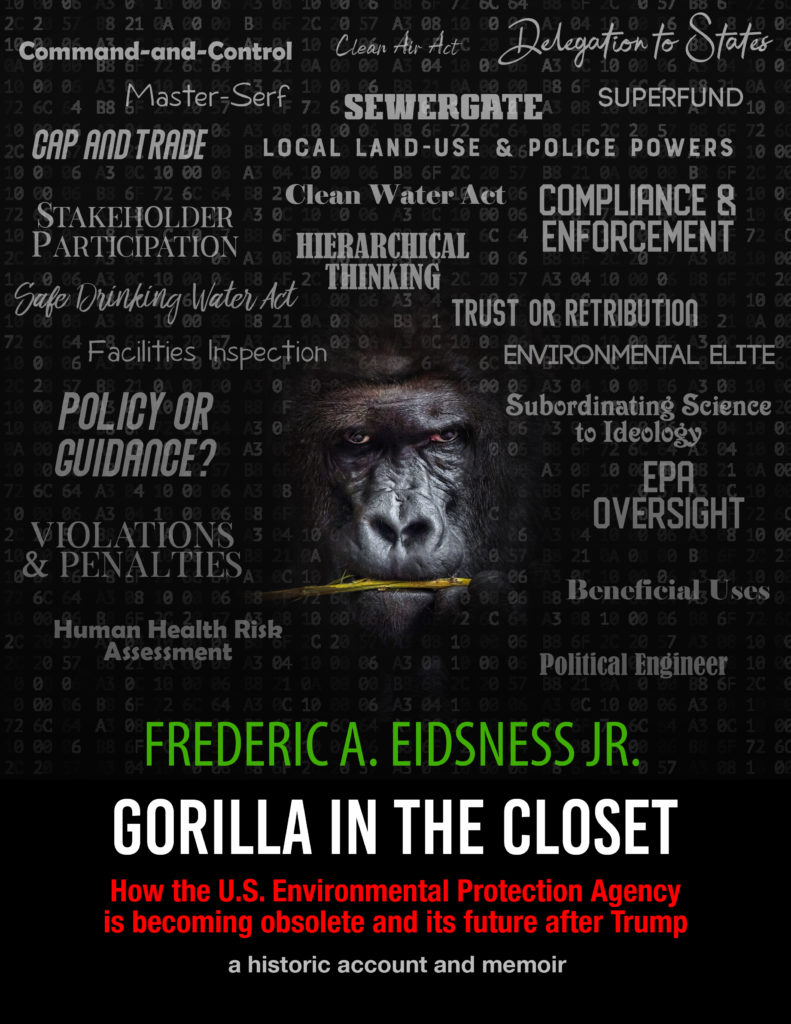
Gorilla in the Closet is available on
Barnes & Noble and Amazon.

4.5 Stars from Literary Titan!
In Gorilla In The Closet, author Frederic A Eidsness Jr. dissects and delves into the ins and out of the Environmental Protection Agency to provide a better understanding of the agency and to outline the dramatic restructuring that is needed to reestablish confidence in the agency. The author is deliberate in making this a nonpartisan issue and develops a plan that I think both sides can get behind. Readers will see how both the Democratic and Republican parties want something for the agency that won’t enable it to properly do what it was meant to do.
The author has extensive knowledge of the EPA as he was a critical member of the agency and was involved in the ‘Sewergate’ scandal; which involved the head of the EPA at the time. The author’s expertise is on full display throughout the book and provides significant insight that makes this book both informative and captivating.
There is a lot of information to take in, but readers who follow politics or government policy, even a little, will be able to understand the book. as the author does a great job of explaining things in detail. Those deeply interested in politics will be enthralled with this book as it gives readers a behind-the-scenes look at an agency in the midst of a scandal. Frederic Eidsness Jr. also shares a bit of history about the EPA, sharing information about its infancy back in the 70s, well before it became infused with politics.
With any book on politics, I’m always wondering which side of the aisle the author falls on. The great thing about this book is that the author is able to remain nonpartisan throughout, focusing only on what will make the EPA better. I’ve learned that politics has shaped the EPA up to this point, but the author makes it clear that there is a path forward that can make the EPA better; which conveys a feeling of hope.
With the anecdotes, expert opinions, behind-the-scenes look, history and critical analysis of the agency, the author is also giving the reader an understanding as to why the agency needs to be revamped before then delving into details on how to improve it. The guidance is clear, and the path forward is well-defined in this informative book.
With climate change being a prevailing contemporary issue I feel Gorilla In The Closet is very relevant today. This is an enlightening book that provides a blueprint to make significant changes to an important agency at a critical time in history. The author tackles the subject with intelligence and a matter-of-fact tone that is refreshing.
….Anecdotes leap off the pages in this historical account of the EPA.
Table of Contents
FOREWORD
PREFACE
ACKNOWLEDGMENTS
PROLOGUE: “Were We Bad People?”
PART I: THE EVENTS AND INFLUENCES THAT SHAPED MY POLITICAL AND GOVERNING PHILOSOPHY
Chapter I-1: Bountiful and Limitless Natural Environment
Chapter I-2: Engineers Are “Good Guys” Who Solve Problems
Chapter I-3: Everything Is Connected to Everything Else
Chapter I-4: Education Comes in Many Forms
Chapter I-5: Government by Invasion and Intrusion
Chapter I-6: Environmental Activism and the Birth of “Process”
PART II: EARLY DAYS OF IMPLEMENTING THE FEDERAL CLEAN WATER ACT
Chapter II-1: Genesis of Federal Dominance, Hero Legislators, and the Birth of Environmental Elitism
Chapter II-2: Environmental Protection from the Top Down
Chapter II-3: EPA’s Anatomy
Chapter II-4: The Water Pollution Control Implementation Strategy
Chapter II-5: Tough Choices — Painful and Confusing Implementation
Chapter II-6: An Unheeded Prophesy of Failure — Technology and Water Quality-Based NPDES Permits
Chapter ll-7: Effluent Guideline Regulations and Permit Writing — Exposing the Secret and What Happened in Reality
Chapter II-8: Municipal Pollution Control
Chapter II-9: Environmental Protection from the Bottom Up — The Alternative Universe
Chapter II-10: EPA’s Reckless Presumptive Applicability Policy
PART III: WATER POLLUTION CONTROL FROM THE BOTTOM UP — A CASE STUDY
Chapter III-1: “Go West, Young Man”
Chapter III-2: The Story of a Changing Environment Rooted in Early Water Resources Development
Chapter III-3: Water Reclamation Arrives at the Front Range of Colorado
Chapter III-4: First in Time Is First in Right
Chapter III-5: The Carter “Hit List”
Chapter III-6: Organizing the 208 Study, Deploying People, Processes and Tools
Chapter III-7: Goals, Objectives and Principles Reflecting Local Values
Chapter III-8: What Is the Problem?
Chapter III-9: Bridging the Gap Between WQS as an “Ideal” and the Scientific and Technical Reality
Chapter III-10: All Politics Is Local
Chapter III-11: Water Quality Management Planning at the Local Level Can Work — The Proof is in the Doing
Chapter III-12: Retrospective of a Flawed Federal Mandate and a Look Ahead to Future WQM Planning
PART IV: SEWERGATE: HIT LISTS, SWEETHEART DEALS AND SHREDDERS
Chapter IV-1: (Another) Mr. Eidsness Goes to Washington
Chapter IV-2: Birth of a Political Engineer
Chapter IV-3: My Letter to Senator Armstrong
Chapter IV-4: Waterside Mall
Chapter IV-5: The Gorsuch Team
Chapter IV-6: In Her Own Words
Chapter IV-7 Confirmation and Promises Made
Chapter IV-8: Clearing the Backlog
Chapter IV-9: Managing the Unmanageable
Chapter IV-10: The Missing Link — Water Quality Standards-to-Permits
Chapter IV-11: The National Municipal Policy
Chapter IV-12: The Enforcement Debacle
Chapter IV-13: The Melting of the Ice Queen and the Return of Mr. Clean
PART V: THE FUTURE — CHANGING BEHAVIORS AND RELATIONSHIPS, REENERGIZING THE QUEST FOR SAFE, CLEAN WATER, AND A PLAN FOR EPA
Chapter V-1: Victims, Victims Everywhere
Chapter V-2: Trust and Retribution
Chapter V-3: Chevron’s Marzone Superfund Project Breaks the Adversarial Mold
Chapter V-4: Empowerment in Environmental Decision-Making
Chapter V-5: The Future of Environmental Protection and the Case for Change
Chapter V-6: Marshalling In a New Era of Environmentalism — The New National Environmental Protection Commission (NEPC)
EPILOGUE
Carbon Audit Program
LIST OF ILLUSTRATIONS
LIST OF PHOTOGRAPHS
GLOSSARY OF ACRONYMS
INDEX
ABOUT THE AUTHOR
Read the excerpts below and visit the blog.
Who Is Eric Eidsness and What Does He Think?
My father always joked, “You pull the chain, we do the rest.” As the son of a sanitary engineer who cast a big shadow, I had to define myself, what kind of a professional engineer I would become, and why. I became a P.E. of a different sort — a “political engineer.” I meant to bring that perspective to Washington, D.C. where my father was born and where three generations of Eidsness men had served honorably in the service of their country. See more on the blog…
EPA’s Leadership
Hubris is the bane of all new political appointees who feel they have all the answers and their predecessors did everything wrong. Having all the answers but not knowing what the question is, is quicksand. See more on the blog…
EPA’s Organization and Management
Little did I realize at the time that organization and key management decisions, including omissions made by EPA’s top political leaders in Washington, D.C. at the same time, were making the same decentralization decision in the 10 regional offices and similarly taking a hands-off or laissez-faire attitude towards fulfilling the need to develop standard operating procedures in areas vital to EPA’s success and driving them through the hierarchy, from HQ to the 10 regional offices and 57 states and territories. Rather than grow into the job as a strong organizational manager, Jack Ravan (my boss and regional administrator in Region 4, Atlanta) became the ultimate “politician.” His behavior seemed motivated to not come down on the wrong side of an issue. See more on the blog…
EPA’s Behavior and Orientation
Jack Ravan was one political patronage appointee with no background or training whatsoever that even remotely related to EPA’s mission. The scuttlebutt among career employees, including my boss Joe Franzmathes, who frequently spoke to me as a confidant, was that EPA was not going to be a regulatory agency driven by science, engineering, and technology. It was, instead, a political organization that would suborn science and technology if politically expedient to do so. See more on the blog…
Blowback from the Regulated Community
By the time of the Reagan Administration, EPA had earned a reputation with many states, local governments, and the regulated community as confrontational, arrogant, and condescending, suborning science to pure ideology, pursuing a regulatory agenda of “writing all the laws allow” in a manner that was overbearing, overprescriptive, often confusing and more. EPA was a federal agency with little accountability and lacked perspective of the social and economic forces that underwrite environmental protection decisions at the local level and the state and local institutions responsible for taking action… See more on the blog…
Politics of Pollution Control
We were being hoisted on our own petard by a bunch of unaccountable White House bureaucrats assigned to OMB. See more on the blog…
Enforcement
At EPA’s inception, William Ruckelshaus took steps to meet the most imperative issue, “which was establishing the credibility of the agency and demonstrating the willingness of the central government, and the political process, to respond to the legitimate demands of the people.” In his 1993 interview for EPA’s Oral History, Ruckelshaus explains how some American industrialists “ …believed environmentalism was a fad, a lot of nonsense that would go away if they just hunkered down, fought, and publicly confronted us. They couldn’t have been more wrong. When they decided to confront (me) or the Agency … it was simple to take them on. We couldn’t have invented any better antagonist for the purpose of showing that this was serious business, that the agency was serious about its mission.’ See more on the blog…
The Environmental Elite and Lobby
I learned after the fact that what I did not know before I returned to EPA in September 1981 would at the least blindside me about how to engage with the Congress and my critics in a debate over reforming WQS as an effective regulatory tool, but indeed resulted in mistakes of my own making. I was well equipped to propose technical changes to the means and methods EPA/states used to adopt and implement WQS, but not on firm ground regarding certain policies because of my engineering orientation and lack of public policy experience at the national level. See more on the blog…
William D. Ruckelshaus
Ruckelshaus’ prominent role in ordering and announcing to the press and hence to the world these first municipal and industrial water pollution enforcement cases denoted that the implementation of EPA’s enforcement policies and subsequent rollout of additional enforcement cases would be based on “personality-driven management style,” and not system or organizational-driven management styles. I do not believe this was Ruckelshaus’ intent. See more on the blog…
Anne McGill Gorsuch
“I believe that EPA can contribute greatly by seizing the initiative in two specific areas, regulatory reform and the new federalism. In the future, EPA will contribute to the decision-making process from the banks of this local, now much cleaner, Potomac to the local courthouses and the state capitals. We will desert an adversary role, and the EPA will seek to bring state governments in as full and active partners in the achievement of our environmental efforts … As to regulatory reform, it is my hope that the EPA of the Reagan Administration be remembered for the amount of money it has saved the taxpayer because we streamlined regulations, cut down on permit-processing time and we, together, cut back on the required paperwork for EPA projects … it is also vital that we shed the image of inflexible regulators and actually find ways to ease the paperwork and the reporting burden of businesses and community.” Anne McGill Gorsuch before EPA employees on May 21, 1981. See more on the blog…
